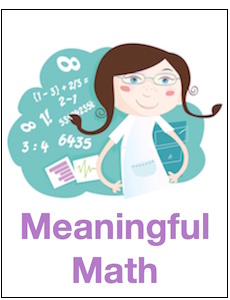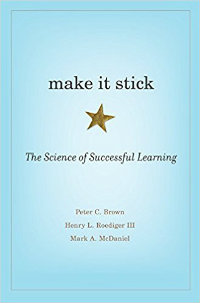Helping Students Recall Core Math Concepts
A MiddleWeb Blog
 Last summer I read Make It Stick: The Science of Successful Learning by Peter C. Brown. The book explains how the majority of ideas we have about studying and retaining information are incorrect, and often the most effective learning strategies are counterintuitive.
Last summer I read Make It Stick: The Science of Successful Learning by Peter C. Brown. The book explains how the majority of ideas we have about studying and retaining information are incorrect, and often the most effective learning strategies are counterintuitive.
As the title suggests, the book focuses on techniques that help make learning stick or that help students “remember longer.”
The book made an impression on me because my math students seem to have such a difficult time retaining basic concepts and information, even from one unit to the next.
Why Is It Important to Retain Information?
In math it is very important to retain and be able to apply previously learned concepts. For example, in Algebra 2 with Trig we are currently studying the unit circle and the trig ratios sine, cosine, and tangent.
The previously learned concepts my students need to be successful include, but are not limited to, special right triangles, the Pythagorean theorem, complex fractions, adding fractions, circumference, and rationalizing the denominator.
Simply put, every step along the way – from the primary grades to college – math builds on itself. It requires a constant retrieval of previously learned skills. If students are unable to retrieve those skills, they are at a disadvantage.
The Book Make It Stick: The Science of Successful Learning

There would be no way to share all the helpful strategies shared by Brown, Roediger and McDaniel in one article. I want to focus on just one idea I took away from the book: spaced practice.
The idea of spaced practice is to leave enough time between initial learning and a return to it so that a little forgetting has occurred and “retrieval essentially involves relearning the material” (page 63).
How to Implement Spaced Practice
Even though I recognized the value of spaced practice as a way to help students retain information, I couldn’t figure out how to implement it in my classroom. I couldn’t think of a way to space the homework that wouldn’t require me to create pages of spreadsheets to keep track – a level of organization that I don’t possess.
However, recently we began preparing our high school kids for their end of year test. In my Algebra 2 with Trig I have 10th and 11th graders (and a few seniors) who take three different math end-of-year assessments. It is challenging when it comes time to prepare students for different tests, while continuing to teach our curriculum.

Students would complete 15 different IXLs in the space of the three weeks with the majority of the work to be completed outside of class – but allowing some class time to work and get help. The IXLs covered concepts that students had learned throughout the year, and going all the way back to 6th or 7th grade.
If you are unfamiliar with IXL, it is a K-12 online learning platform that allows students in all grades to practice math skills. It’s arranged by content standards and also by subject. IXL is primarily for practicing math skills and for that it’s pretty effective.
Note: I’m in no way promoting this platform; I’m using it because I have a paid subscription through my school. (You could use it without the paid subscription, but students are limited to 5 problems and you would have no record of their work.) If you don’t have access to the IXL platform, you could implement spaced practice with your textbook. I also think you do something similar with Khan Academy. For me it was all about using what resources I had available.
The Benefits of Observing Student Practice
When I gave students time to work on their IXL assignment in class, I would walk around the room to help them and to observe. Seeing students work to remember previously learned concepts gave me an opportunity to watch “spaced practice” in action. I saw students trying to retrieve information and in the end actually relearning the concepts.
For example, I sat with a student working on a problem that required using the quadratic equation. The student had had about six weeks to “forget.” You could almost see the wheels turning in her mind as she retrieved the formula and slowly started remembering the process. I can’t help but think that will help cement that concept in her mind.
Seeing how students used the IXLs to call back previously learned concepts, I became excited. I realized that I could use this platform to provide “spaced practice.”
The way I intend to use it is this: when we move on to the next unit, I will give students an assignment to be completed which will consist of practicing IXLs covering the material from the previous unit. I plan to have the assignments come due every three weeks. Students will have to work some outside of class, and I can provide some class time for students to get help. (Our students also have three days a week in which they have a designated study time in the middle of the day to get help from any teacher they need help from.)
I realize there’s more to spaced practice than “lagging” homework assignments, but this is my way of sticking my toe in the water. My students should have an opportunity to revisit material throughout the year, not just when preparing for a test.
I know I have to do better in this area. My goal is two-fold: (1) help students call back those important concepts they will continue to need and (2) help them see that they can’t learn material just for a test and then forget it.
Further Reading
There was an excellent presentation at Twitter Math Camp which dealt with the principles found in Make it Stick, led by Anna Vance. She has also written about it in her blog and has done a great job demonstrating how to spiral homework assignments so that students are always refreshing their memory on previously learned concepts.
On her blog Vance mentions that her homework assignments consist of 2 problems from current material, 4 from past material, and 2 from much earlier material.
Also, Julie Reulbach, from the I Speak Math blog, has written about “lagged” homework assignments in a way that I think is very informative.
Discover more about spiral curriculum here.
Looking Ahead to Next Year – with Enthusiasm!
I’m learning I have to be realistic, I have to implement new things in a way that is doable and sustainable. That’s where IXLs come in. I also plan to reread Make It Stick over the summer and will hopefully have more ideas for my classroom.
But in any case it’s nice to be excited and looking forward to the next year. I would love to hear from anyone who has suggestions regarding how to space, lag, or spiral assignments or content in middle or high school math. Hopefully over the summer I can get organized and be ready to go!





































Delta Math is a free resource.
Yes. In fact Michelle talks about Delta Math at length in this more recent post:
https://www.middleweb.com/39001/my-opinions-about-two-major-math-resources/